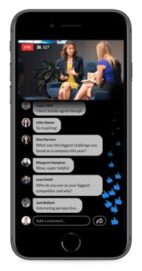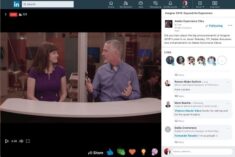Apathy is a lack of interest, enthusiasm, or concern. It is synonymous with indifference. For B2B sales, apathy is a deal-killer. For B2B marketing, apathy is a non-starter.
Apathy may just be one of the greatest threats facing any B2B organization. Consumers have an abundance of other things to read and watch, and a plethora of other vendors to choose from in nearly every industry.
From where I sit, apathy is so scary because it threatens our core responsibility as marketers to create engagement, capture attention, drive interest, build loyalty, and ultimately drive action and change. None of that is possible unless a buyer is willing to lean in, engage with, and consume our content.
In short, we have to make buyers give a damn.
How do marketers use video to defeat buyer apathy?
The antidote to apathy is curiosity. Curiosity is what makes human beings give something their attention, engage with it, and ultimately take action because of it. Curiosity is what ignites change.
For marketers, video has become a standard tool in our toolkits to drive curiosity among buyers. Eighty-seven percent of businesses now use video as a marketing tool, and more than ever (83%) say it gives them a good return on their investment. However, 90% of video marketers feel the level of competition and noise has increased in the past year.
How do we ensure our videos stand out? How do B2B firms use video marketing to break through to indifferent buyers?
A couple of weeks ago at PLAY 2019 in Boston, I presented a few ways to defeat buyer apathy using videos. Below, I’ve included five of these tips and some relevant examples, and my take on why they’re so effective:
1. Know your niche, serve them well
Sixty percent of B2B brands admit they don’t understand their buyers, according to SiriusDecisions . Yet, buyers are 50% more likely to buy when they see personal value for them, or a positive impact on their career.
Before Eloqua was bought by Oracle for its marketing automation capabilities, it ran a video series about Modern Mark. It demonstrated exactly how well this brand understood its audience, and allowed potential buyers to see personal value through the eyes of this character, who was personally benefiting from the advantages Eloqua’s marketing technology delivered.
2. Talk like a human being
One surefire way to make a buyer stop listening to your video is to speak the way our company boilerplates do, that is, heavy-handed and full of buzzwords.
This product demo from Lucidchart shows us the power of simply talking like a human being.
For future evidence of how refreshing this is, check the comments on YouTube:



This customer testimonial from Slack achieves the same simple, approachable, engaging tone that makes you want to watch to the end. (When was the last time you wanted to watch a customer testimonial video through to the end?)
3. Drive urgency
Sure, we’re familiar with FUD: fear, uncertainty, and doubt. It’s a standard tool in the security and risk industry as we try to drive urgency among buyers. But fear-mongering gets old when every vendor in the space uses it. It also has a tendency to feel hyperbolic.
This video from Cisco took a ransomware attack storyline and flipped it on its head, exploring the attack from the perspective of the hacker themselves. It’s a script that makes your heart pound as you watch for its conclusion, and demonstrates how well Cisco understands each angle of this threat.
4. Earn trust
Forty-two percent of buyers don’t know which companies to trust, per Edelman . This was especially true in the world of SEO consultants before Rand Fishkin came along. The founder of Moz became known for being a transparent, educational resource among a sea of agencies keeping their SEO knowledge closely guarded.
To them, trade secrets were their secret sauce. To Rand, it became the foundation for a thought leadership platform that earned trust in an industry of secret tactics and shady business. His honesty led him to become the go-to authority on SEO, and his whiteboard Friday videos became a weekly example of this transparency.
In his book, Lost and Founder , Rand describes:
“We were called crazy and foolish for oversharing so much about the mechanics of the business. But we also became trusted, and, especially because the field of SEO and the broader world of tech startups are so often impenetrably secretive, it paid off.”
5. Be where customers want you to be
One major driver of apathy is simply invisibility. Why would I watch your video if it takes remarkable effort to find it in the first place?
Are you gating all of your video content? Relying too much on email to promote it? Putting all of your eggs in the YouTube basket? Hiding it below the fold on some obscure page on your site, or blog post? Liberate your video content!
According to the Content Marketing Institute , 70% of B2B marketers use sponsored content on social media to promote their content. In their study, this was the #1 paid content distribution method.
For B2B firms, I strongly recommend investing in video on LinkedIn. The platform now boasts 500 million members, 260M of which log in monthly. Forty percent of those users are on the platform every day. Note: These are not just job-seekers; 61M are senior-level influencers.
Per LinkedIn , these users spend almost 3X more time watching video ads than with static sponsored content. “Video is the fastest growing format on our platform right now, and the one most likely to get people talking,” said Pete Davies, LinkedIn’s director of product management.
Leverage this engagement to give your videos a boost, and consider trying their new live video broadcast service , LinkedIn Live. The example below demonstrates how Adobe Experience Cloud leveraged this during their recent 2019 Magento conference, broadcasting interviews live from the show floor .

It’s a beautiful interface on both desktop and mobile—and is a great way to be exactly where your audience is.
Overcoming buyer apathy is one of many challenges B2B marketers face over the coming months. But, it’s at the core of what makes our job so exciting. It just takes creativity and empathy in our video marketing strategy.


